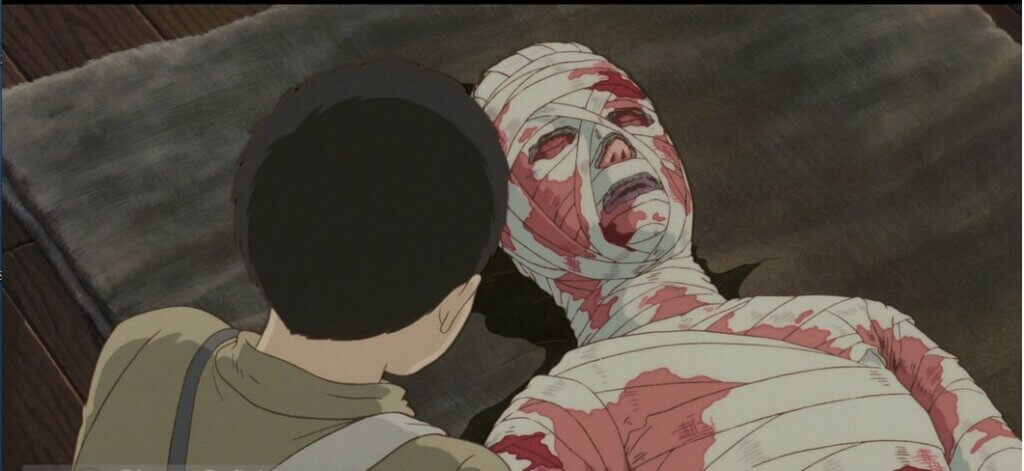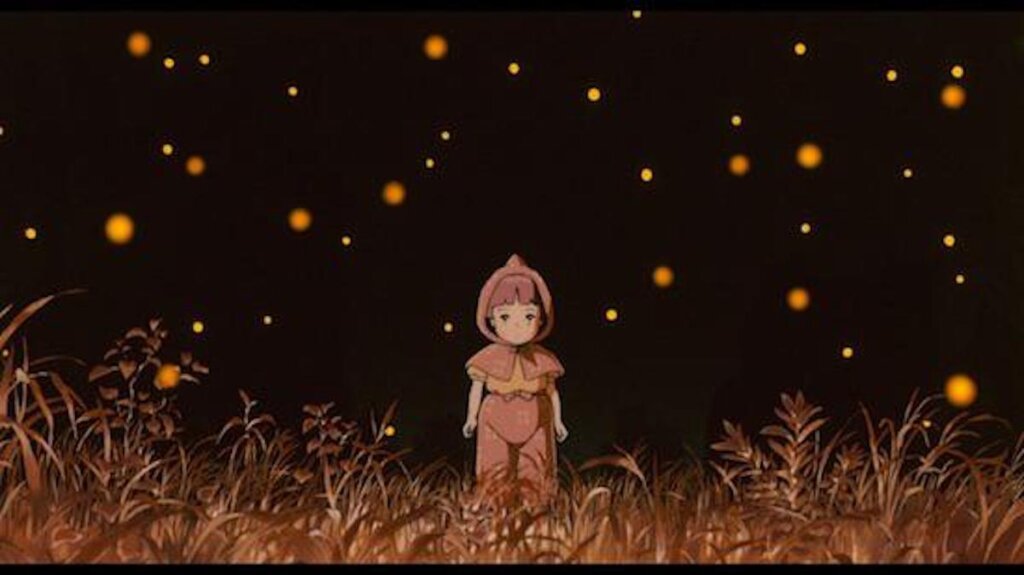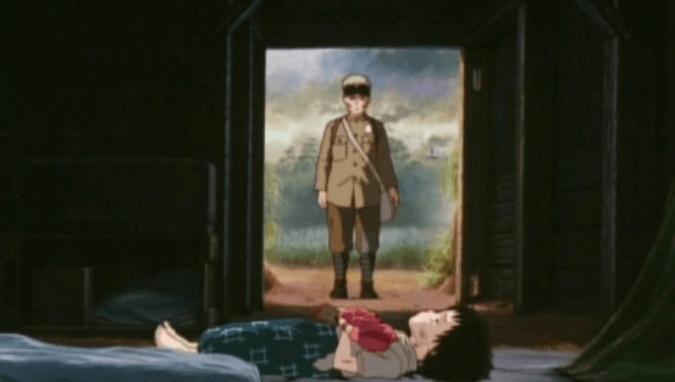Responsibility and Victimization in Grave of the Fireflies
Targeting non-combatants has been a strategic and controversial practice in wartime for centuries. Despite laws established during the first, second, and third Geneva Conventions, civilian casualties continued to rise during and after World War II. These casualties were particularly high for the people of Japan during the targeted US firebomb raids toward the end of the war. These devastating attacks, combined with the effects of the nuclear attacks on Hiroshima and Nagasaki, led to a national sense of victimhood among the Japanese people following the end of the war in 1945. In this essay, I will look at the relationship between responsibility and victimization in Grave of the Fireflies (1988).
Many literary accounts from Japanese survivors reflect this victimization, including Nosaka Akiyuki’s 1967 short story “Grave of the Fireflies,” which depicts a partially fictionalized version of his own experiences during the incendiary bombings of his home in Kobe, Japan. In 1988, Japanese anime director Isao Takahata infused his own experiences as a child during the bombings into his animated adaptation of Nosaka’s story, and emphasized the national despair of the Japanese people during this time in history. Despite this emphasis on the Japanese as victims, the themes in Grave of the Fireflies reflect the tension between national responsibility and civilian victimization in post-war Japan.
In “Targeting Civilians in War,” Alexander Downes defines civilian victimization as “a military strategy chosen by political or military elites that targets and kills noncombatants intentionally or which fails to discriminate between combatants and noncombatants and thus kills large numbers of the latter” (Downes 13). Three weeks prior to the attacks on Pearl Harbor, Army chief of staff General George C. Marshall was quoted as saying that, if the US did invade Japan, the United States military would be “merciless” and “flying fortresses [would] be dispatched immediately to set the paper cities of Japan on fire…there won’t be any hesitation about bombing civilians – it will be all out”” (Downes 123).
This was not an empty promise, as the United States military quickly established the conflict with Japan as a war of attrition. Since the systematic depletion of the Japanese population was the United States’ main priority, the targeting of urban areas with large concentrations of noncombatants became common practice. Starting in March of 1945, the US military began bombing 66 Japanese cities, resulting in death tolls estimated at 330,000, with 2.5 million homes destroyed and about 8.5 million Japanese civilians displaced (Downes 117).
Nosaka Akiyuki’s short story, “Grave of the Fireflies,” is based on these strategic incendiary bombings of several of Japan’s largest cities, specifically Kobe. In the story, Nosaka recalls his days living in Kobe after being separated from his parents during the June bombings. Following the attacks, Nosaka became the sole caregiver for his one and a half year old sister, Keiko. Nosaka was forced to steal food and sell off old family heirlooms to survive. The siblings drifted between staying with relatives and living in the horribly over-crowded and disease-ridden bomb shelters.

As Nosaka became increasingly desperate to find food, he began mistreating his sister and eating her share of the food. Eventually, Keiko died under his care, which prompted Nosaka to simultaneously express his guilt and the victimhood of his family (and the Japanese civilian population as a whole) over twenty years later in “Grave of the Fireflies” (Stahl). In the animated version, Takahata uses the characters of Seita (representing Nosaka) and Setsuko (representing Keiko) to retell Nosaka’s tragic story.
In Grave of the Fireflies, Takahata presents Seita and Setsuko as innocent victims of war. While some critics of the film argue that the film emphasizes Japanese victimhood to avoid a sense of responsibility for certain atrocities during the war (such as events perpetrated by the Japanese in Nanking), the narrative actually does allow for responsibility on the part of Japan while also using the experiences of Seita and Setsuko as examples of the horrible effects of war (Stahl 161). The film begins with Seita’s narration recalling his own death (while Seita’s death is not historically accurate, it furthers the image of both children as victims of war).
As Seita’s spirit awakens from his lifeless body, he meets with Setsuko’s spirit to recount how they both came to die. Following the bombing and subsequent destruction of Kobe, 14-year-old Seita flees to an overcrowded bomb shelter with 4-year-old Setsuko on his back. Their mother was taken to the shelter after being badly burned during the raid, and even though Seita abandoned her during the raid, he hopes that they can be reunited at the shelter. However, their mother dies at the shelter and Seita decides to go stay with his aunt. Not long after the children arrive at their aunt’s house, she begins to resent them for not working to earn food, and Seita eventually leaves so that he and Keiko can be free of his aunt and society in general. Seita takes Keiko to an old, abandoned cave, and while at first they prosper, they quickly run out of food, and Keiko’s health declines. After failing to buy or steal enough to feed Keiko, she dies of starvation, and Seita dies soon after.
» You Might Like: Feminist Film Theory and Psychoanalysis
From the very beginning, the narrative evokes sympathy for the lost children, while also pinning the responsibility for Setsuko’s death on Seita and Japanese society as a whole. Seita’s decision to leave the security of his aunt’s home is driven by his own desire to prove his manliness. As a boy caught in the transition between youth and adulthood, Seita seeks to probe “the boundaries of his own identity as a man and as a protector” (Goldberg 47). This urge prompts him to abandon society and attempt to care for Setsuko on his own. Throughout the narrative, images of Seita’s father (who is off fighting in the war) are used to reflect the ideal image of Japanese manhood, which fuels Seita’s need to prove his own masculinity.
This conception of manhood was embedded in the strong ideals of nationalism and communal strength in Japanese culture at the time. While Seita strives for these ideals, the narrative also works to critique them and thus place some responsibility for the atrocities of the war on Japanese society. Towards the beginning of the film, Seita and Setsuko come across a group of survivors as they are fleeing Kobe. They see a “lone figure in a uniform, silhouetted in front of the burning town and behind cowering survivors” (Goldberg 43). The man waves a mop around and repeatedly shouts, “Long live the Emperor!” He is a member of the fire brigade, and yet rather than working to put out the fires around him, he chooses to spout nationalistic propaganda. This figure reflects the failure of strong nationalism to save the people of Japan, thus perpetuating the destruction of Kobe and indirectly allowing the deaths of the children (Goldberg 43).
Despite the critiques of Japanese nationalism, the central focus of the narrative is the pain and despair of the children, particularly Setsuko. At the beginning of the film, prior to and even following the bombing of Kobe, Setsuko represents the innocence and fragility of childhood. Scenes of Setsuko playing with Seita are juxtaposed with scenes of her begging for food and crying out in pain. These scenes emphasize her complete dependence on Seita, and her death confirms his failure to protect and care for her.
Visual cues also help document Setsuko’s declining health and reiterate her status as a victim of a larger wrong. Once the two children move to the abandoned cave, food becomes scarce. The once young and happy Setsuko suddenly looks haggard and old. The spectator is made to sympathize with Setsuko’s plight and is able to see her pain, which prompts speculation as to who is to blame for her eventual death. The most obvious answer would be the United States military, as they bombed her village and forced her separation from her family. Yet another answer would be Seita, as he made the choice to take her away from the relative security of society and failed to care for her on his own. However, the narrative seeks to reach a more complex conclusion.

Once the film establishes Setsuko (and to a lesser extent, Seita and the rest of the Japanese civilians) as victims of the war, it also works to accept a certain level of responsibility for the wartime atrocities on behalf of Japanese society. While Nosaka’s original story served as a way to personally work through his own grief and guilt over the death of his infant sister, Takahata modifies the story to emphasize larger social themes of “mourning, memorialization, and responsibility” (Stahl 165). The narrative remembers the innocent men, women, and children who died during the war, but also works to take responsibility for those deaths.
For example, when Seita first runs away from Kobe during the bombings, he abandons his mother, who eventually dies from burn-related injuries. Later, he leaves the security of his aunt’s home to exercise his own freedom and flaunt his newfound sense of masculinity, which eventually leads to his sister’s death. Seita runs away from the village out of fear, rather than staying behind to help his family and community. When he leaves his aunt’s house, he puts his own desires over the needs of his sister, who is completely dependent on him to survive. Seita abandons the “communal ideals” that were so prevalent in wartime Japan in favor of his own personal gain (Goldberg 40). In this way, much of the responsibility for Setsuko’s death lies with Seita as her brother and sole protector.
However, Seita does not bear all of the responsibility. While Japanese culture in 1945 did promote concepts of community and the strength of the whole, it also ingrained concepts of blind nationalism and militarism into the minds of its people. Seita’s dreams of joining his father in battle reflect a “national fantasy of war” that blinded him to the needs of his sister and community at large (Goldberg 41). Takahata criticizes these jingoistic ideals of Japanese society and the lasting effects that these ideals had on Japanese survivors.
In this way, the film simultaneously portrays the Japanese people as victims and as active participants in the war. While the people are victims of nationalistic propaganda and wartime violence, they are also partly responsible for wartime atrocities through their abandonment of communal ideals and their “selfishness masked by nationalistic fervor” (Goldberg 40). This selfishness is most evident in Seita’s brief interactions with adults during the film. When Seita sneaks into a village to steal food, he is caught and thrown in jail. No one is interested in listening to his story because they are all struggling to survive. The civilian victims suffer more due to their change from communalism to selfish survivalism.
Grave of the Fireflies serves as a memorial for the 1945 bombings in Japan and a shift from purely victimization narratives to a call for responsibility. While many in post-war Japan saw themselves as victims of excessive US bombings and high civilian casualties (and rightly so), these feelings also downplayed the atrocities that these victims inflicted on each other. Seita and Setsuko embody this duality of victim and perpetrator.
While Seita and Setsuko were both innocent victims of war, Seita also served a dual role because of his selfishness and misguided nationalistic pride, which led to his sister’s death. These themes of victimization and responsibility reflect a “transgenerational endeavor of working over, working through and coming to terms with historical trauma and victimization” in Japan (Stahl 195). In this way, Takahata’s victimization in Grave of the Fireflies reevaluates the concept of Japanese victimization and applies a new narrative of post-war accountability to future generations in Japan.
Stahl, David C., and Mark Williams. “Victimization and “Response-ability”: Remembering, Representing, and Working Through Trauma in Grave of the Fireflies.” Imag(in)ing the War in Japan: Representing and Responding to Trauma in Postwar Literature and Film. Leiden: Brill, 2010. N. pag. Print.
Downes, Alexander B. Targeting Civilians in War. Ithaca: Cornell UP, 2008. Print.
Goldberg, Wendy. “Transcending the Victim’s History: Takahata Isao’s Grave of the Fireflies.” Mechademia 4 (2009): 39-52. Print.
If you’d like to read more film theory essays, consult the Philosophy in Film Homepage!


Good review of a thoughtful and sensitive film that uses animation to tell a difficult story.
Enjoyed reading your review! You have a great blog here. I also like to analyse films from psychological, philosophical and historical standpoints.
Wow, you added a completely new dimension to this film that I wasn’t aware of beforehand. Your analysis is in-depth and is one of the best I’ve read in regards to the film. I’ll definitely be reading more of your reviews. Well done, you’re doing a great job!
Lovely Review and analysis. This is quite old, but I will mention:
“Yet another answer would be Setsuko, as he made the choice to take her away from the relative security of society and failed to care for her on his own. ”
Should the name here not be Seita’s?
Just fixed it, thanks for pointing it out for me!
It’s clear from this review is that the perspective is from a western culture. From an Asian perspective, we would have to disagree with some of the author’s points. There was a tendency to over analyze the story, but for many Asians (few Japanese wanted to watch this film), it was really quite basic, to see the pain and guilt of Mr. Nosaka through this story, to live through their misery in this art form.